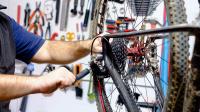Cogging

Martin Vinson
All hub dynamos feel like that. It’s called ‘cogging’ and occurs because the magnets attract corresponding segments of the armature. So when you turn it, you must at first drag those corresponding poles out of synch, then feel them push forwards into synch again. But you feel the effort of pulling apart much more than you appreciate the forward push. The energy taken and returned will nevertheless be almost equal, minus a small loss from eddy currents. Better-made generators have smaller eddy currents and a smaller air-gap between armature and magnets. Both improve efficiency, but the latter may paradoxically strengthen the cogging effect. So this feeling of square bearings tells you nothing at all about the dynamic drag from a hub generator.
When the axle is clamped in a fork and the wheel is spinning, it acts as a flywheel, repeatedly giving and receiving energy as the magnetic poles are pulled apart then pull themselves together. And even if the hub has the same net drag as a regular hub, it will be stopped from spinning sooner, just as soon as the wheel is spinning so slowly that it no longer has enough kinetic energy to pull the poles apart. So counting turns to standstill is no good. Counting turns between two given speeds would be good, but is much harder to do.
Holding the axle in your fingers is even worse, because the pull-push energy exchange now involves the lossy materials of the human hand and arm, which sap rotational energy from the spinning wheel and quickly stall it. You can’t tell a darned thing from that!
So don’t worry: this wheel will actually spin a lot better than it feels! And besides, the notion that hub friction might be a significant factor in one bike riding better than another is mostly a cyclist’s fairytale of the ‘Princess and the Pea’ variety. A hub has to have absolutely horrible bearings before it has any noticeable effect. Anyone who thinks they can feel the difference between two more or less okay-running hubs has to be a True Princess!
Chris Juden
This was first published in the February / March 2015 edition of Cycling UK's Cycle magazine.